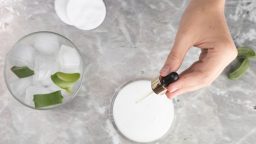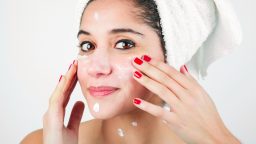A solid skincare routine can make all the difference when it comes to maintaining healthy, glowing skin. With so many products on the market, it can be difficult to know where to start or what steps to follow. The key to an effective skincare routine is consistency, choosing the right products for your skin type, and understanding the order in which they should be applied. In this guide, we’ll walk you through how to build the perfect skincare routine that suits your skin’s needs.
Step 1: Determine Your Skin Type
Before you begin building your skincare routine, it’s essential to identify your skin type. Knowing whether your skin is oily, dry, combination, sensitive, or normal will help you select the right products for your complexion.
Skin Types:
- Oily Skin: Prone to excess shine and clogged pores.
- Dry Skin: Feels tight, rough, or flaky with visible dryness.
- Combination Skin: Oily in some areas (like the T-zone) and dry in others.
- Sensitive Skin: Prone to irritation, redness, or reactions from certain products.
- Normal Skin: Balanced, not too oily or dry.
Once you know your skin type, you can choose products designed to address your skin’s specific needs.
Step 2: Cleanse Your Skin
Cleansing is the first and most crucial step in any skincare routine. Cleansing removes dirt, oil, makeup, and impurities from the skin, leaving it clean and ready to absorb other products. The key is to choose a gentle cleanser that works for your skin type.
For Oily Skin: Choose a gel-based or foaming cleanser to help control oil production without drying out your skin. For Dry Skin: Opt for a creamy or hydrating cleanser that won’t strip the skin of its natural oils. For Sensitive Skin: Look for a fragrance-free, mild cleanser to prevent irritation.
How to Cleanse:
- Use lukewarm water, not hot, as hot water can strip your skin’s moisture.
- Apply a small amount of cleanser to damp skin and massage it gently for about 30 seconds.
- Rinse thoroughly and pat your face dry with a soft towel.
Step 3: Exfoliate (2-3 Times a Week)
Exfoliation is the process of removing dead skin cells that can make your complexion appear dull. It also helps prevent clogged pores and promotes cell turnover. However, exfoliating too often can irritate the skin, so aim to exfoliate 2-3 times a week, depending on your skin type.
There are two types of exfoliators:
- Physical Exfoliants: Scrubs with small grains or beads that manually remove dead skin cells.
- Chemical Exfoliants: Contain acids (like AHAs or BHAs) that dissolve dead skin cells and improve skin texture.
For Oily or Acne-Prone Skin: Go for a salicylic acid-based (BHA) exfoliator, which helps clear pores and control oil. For Dry Skin: Opt for a gentler AHA-based exfoliant like glycolic acid, which helps hydrate the skin while exfoliating. For Sensitive Skin: Use a mild, enzyme-based exfoliant (papaya or pineapple enzymes) or avoid physical exfoliants altogether.
How to Exfoliate:
- Apply the exfoliant to damp skin after cleansing.
- Gently massage for a minute or two, then rinse thoroughly.
- Always follow up with sunscreen after exfoliating, as your skin will be more sensitive to the sun.
Step 4: Apply Toner
Toner helps to balance your skin’s pH levels and tightens pores, prepping your skin to absorb the next steps in your routine. It can also provide additional benefits depending on its ingredients, such as hydration or soothing effects.
For Oily or Acne-Prone Skin: Look for a toner with salicylic acid or witch hazel to help control oil and prevent breakouts. For Dry Skin: Opt for a hydrating toner with ingredients like glycerin or hyaluronic acid to replenish moisture. For Sensitive Skin: Choose a soothing toner with chamomile or aloe vera that calms and hydrates.
How to Apply:
- Apply toner to a cotton pad and gently swipe it across your face, avoiding the eye area.
- You can also apply toner directly to your face using your hands, gently pressing it into the skin.
Step 5: Use Treatment Serums
Serums are highly concentrated treatments designed to target specific skin concerns like fine lines, dark spots, or uneven texture. They’re packed with active ingredients, and a little goes a long way.
For Oily Skin: Look for a mattifying serum with niacinamide or salicylic acid to help control oil and reduce the appearance of pores. For Dry Skin: Go for a hydrating serum with hyaluronic acid, which attracts moisture to the skin and helps plump it up. For Anti-Aging: If you’re looking to reduce wrinkles or improve skin texture, try a retinol serum or a serum with peptides. For Hyperpigmentation: A vitamin C serum can brighten the skin and reduce dark spots.
How to Apply:
- Apply a few drops of the serum to your face after toning, and gently press it into the skin.
- Allow it to absorb before moving on to the next step.
Step 6: Moisturize
Moisturizing helps lock in hydration and creates a barrier to protect the skin from environmental stressors. Even if you have oily skin, moisturizing is crucial to maintaining healthy skin.
For Oily Skin: Choose a lightweight, oil-free moisturizer that won’t clog pores or make your skin greasy. For Dry Skin: Opt for a rich, creamy moisturizer with ingredients like shea butter or ceramides to nourish and lock in moisture. For Sensitive Skin: Look for a fragrance-free, gentle moisturizer with calming ingredients like aloe vera or chamomile.
How to Apply:
- Apply your moisturizer after serum to seal in hydration.
- Gently massage it into your skin in upward strokes.
Step 7: Apply Eye Cream (Optional)
If you have concerns like dark circles, puffiness, or fine lines around your eyes, consider adding an eye cream to your routine. Look for products with ingredients like caffeine, peptides, or hyaluronic acid, which help to hydrate, reduce puffiness, and smooth the skin.
How to Apply:
- Use your ring finger to gently tap a small amount of eye cream under your eyes, focusing on the orbital bone.
- Don’t apply directly to the eyelids.
Step 8: Don’t Forget Sunscreen
Sunscreen is the most crucial step in any skincare routine, no matter your skin type or concern. Sun exposure accelerates the aging process, causes hyperpigmentation, and increases the risk of skin cancer.
For All Skin Types: Use a broad-spectrum sunscreen with SPF 30 or higher. Look for a formula that’s lightweight, non-comedogenic (won’t clog pores), and suitable for your skin type.
How to Apply:
- Apply sunscreen generously to your face, neck, and any exposed areas of your skin.
- Reapply every two hours, or more often if swimming or sweating.
Additional Tips:
- Consistency is key: Stick to your skincare routine for at least a few weeks to see results.
- Patch test new products: Especially if you have sensitive skin, patch test products on a small area of your skin to ensure they don’t cause irritation.
- Don’t overdo it: Avoid using too many active ingredients (like retinol or acids) in one routine to prevent irritation.
Conclusion
Building the perfect skincare routine doesn’t have to be complicated. By understanding your skin type and needs, and using the right products in the correct order, you can achieve healthy, glowing skin. Start with the basics—cleansing, toning, moisturizing, and sunscreen—and build from there with targeted treatments like serums and eye creams. With consistency and the right approach, you’ll see a noticeable difference in the health and appearance of your skin.





